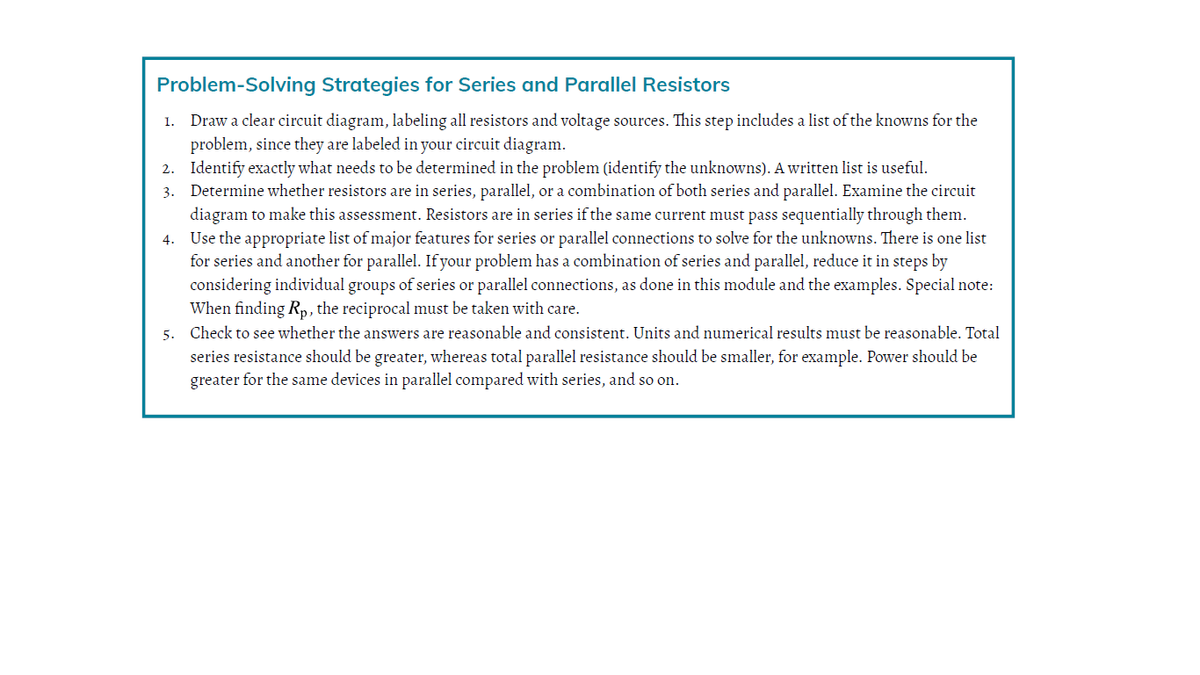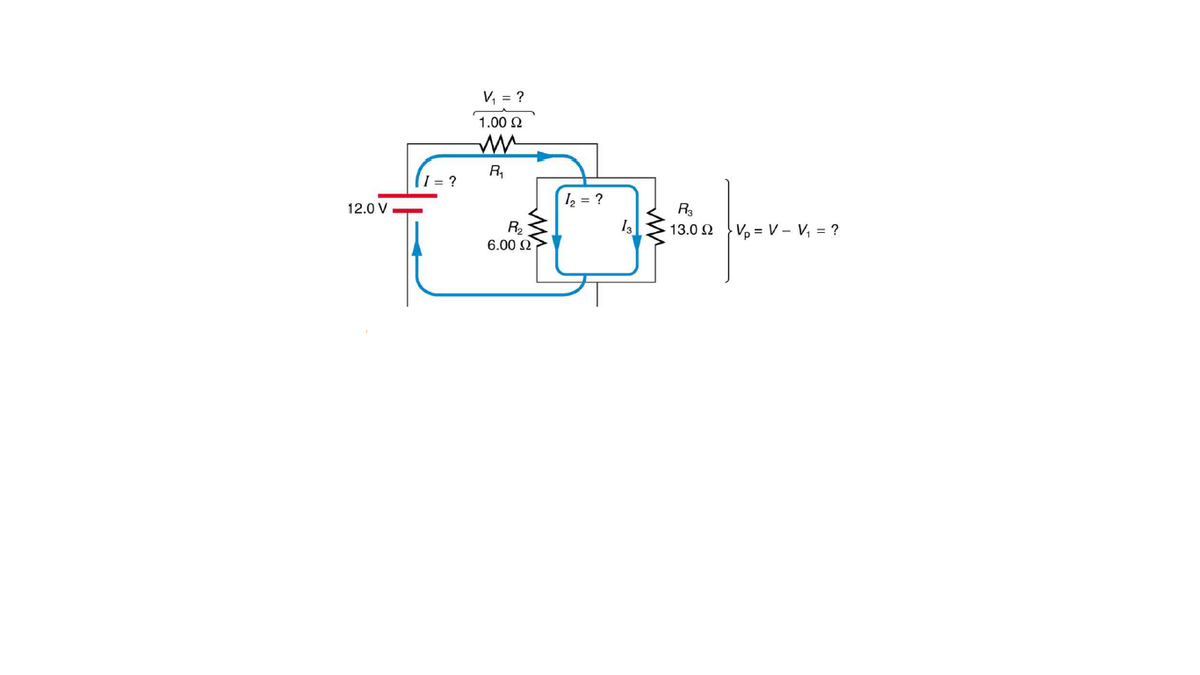Problem-Solving Strategies for Series and Parallel Resistors 1. Draw a clear circuit diagram, labeling all resistors and voltage sources. This step includes a list of the knowns for the problem, since they are labeled in your circuit diagram. 2. Identify exactly what needs to be determined in the problem (identify the unknowns). A written list is useful. 3. Determine whether resistors are in series, parallel, or a combination of both series and parallel. Examine the circuit diagram to make this assessment. Resistors are in series if the same current must pass sequentially through them. 4. Use the appropriate list of major features for series or parallel connections to solve for the unknowns. There is one list for series and another for parallel. If your problem has a combination of series and parallel, reduce it in steps by considering individual groups of series or parallel connections, as done in this module and the examples. Special note: When finding Rp, the reciprocal must be taken with care. 5. Check to see whether the answers are reasonable and consistent. Units and numerical results must be reasonable. Total series resistance should be greater, whereas total parallel resistance should be smaller, for example. Power should be greater for the same devices in parallel compared with series, and so on. V, = ? 1.00 Ω R, I = ? 12 = ? 12.0 V R3 I3 R2 6.00 Ω V, = V – V, = ? 13.0 Ω
Problem-Solving Strategies for Series and Parallel Resistors 1. Draw a clear circuit diagram, labeling all resistors and voltage sources. This step includes a list of the knowns for the problem, since they are labeled in your circuit diagram. 2. Identify exactly what needs to be determined in the problem (identify the unknowns). A written list is useful. 3. Determine whether resistors are in series, parallel, or a combination of both series and parallel. Examine the circuit diagram to make this assessment. Resistors are in series if the same current must pass sequentially through them. 4. Use the appropriate list of major features for series or parallel connections to solve for the unknowns. There is one list for series and another for parallel. If your problem has a combination of series and parallel, reduce it in steps by considering individual groups of series or parallel connections, as done in this module and the examples. Special note: When finding Rp, the reciprocal must be taken with care. 5. Check to see whether the answers are reasonable and consistent. Units and numerical results must be reasonable. Total series resistance should be greater, whereas total parallel resistance should be smaller, for example. Power should be greater for the same devices in parallel compared with series, and so on. V, = ? 1.00 Ω R, I = ? 12 = ? 12.0 V R3 I3 R2 6.00 Ω V, = V – V, = ? 13.0 Ω
Glencoe Physics: Principles and Problems, Student Edition
1st Edition
ISBN:9780078807213
Author:Paul W. Zitzewitz
Publisher:Paul W. Zitzewitz
Chapter24: Magnetic Fields
Section: Chapter Questions
Problem 75A
Related questions
Question
Referring to the example combining series and parallel circuits and Figure, calculate I3 in the following two different ways:
(a) from the known values of I and I2 ; (b) using Ohm’s law for R3.
In both parts explicitly show how you follow the steps in the Problem-Solving Strategies for Series and Parallel Resistors.

Transcribed Image Text:Problem-Solving Strategies for Series and Parallel Resistors
1. Draw a clear circuit diagram, labeling all resistors and voltage sources. This step includes a list of the knowns for the
problem, since they are labeled in your circuit diagram.
2. Identify exactly what needs to be determined in the problem (identify the unknowns). A written list is useful.
3. Determine whether resistors are in series, parallel, or a combination of both series and parallel. Examine the circuit
diagram to make this assessment. Resistors are in series if the same current must pass sequentially through them.
4. Use the appropriate list of major features for series or parallel connections to solve for the unknowns. There is one list
for series and another for parallel. If your problem has a combination of series and parallel, reduce it in steps by
considering individual groups of series or parallel connections, as done in this module and the examples. Special note:
When finding Rp, the reciprocal must be taken with care.
5. Check to see whether the answers are reasonable and consistent. Units and numerical results must be reasonable. Total
series resistance should be greater, whereas total parallel resistance should be smaller, for example. Power should be
greater for the same devices in parallel compared with series, and so on.

Transcribed Image Text:V, = ?
1.00 Ω
R,
I = ?
12 = ?
12.0 V
R3
I3
R2
6.00 Ω
V, = V – V, = ?
13.0 Ω
Expert Solution
This question has been solved!
Explore an expertly crafted, step-by-step solution for a thorough understanding of key concepts.
This is a popular solution!
Trending now
This is a popular solution!
Step by step
Solved in 2 steps

Knowledge Booster
Learn more about
Need a deep-dive on the concept behind this application? Look no further. Learn more about this topic, physics and related others by exploring similar questions and additional content below.Recommended textbooks for you

Glencoe Physics: Principles and Problems, Student…
Physics
ISBN:
9780078807213
Author:
Paul W. Zitzewitz
Publisher:
Glencoe/McGraw-Hill

Glencoe Physics: Principles and Problems, Student…
Physics
ISBN:
9780078807213
Author:
Paul W. Zitzewitz
Publisher:
Glencoe/McGraw-Hill